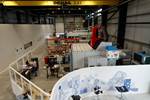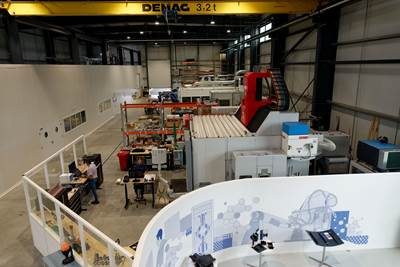ELG Carbon Fibre’s new nonwoven line manufactures 2.7m wide recycled carbon mats
The company believes the materials will appeal to OEMs in the transportation sector seeking cost effective alternatives to virgin carbon fiber for vehicle lightweighting.
Share
Read Next
ELG Carbon Fibre Ltd. has started production of a range of nonwoven mats on a new production line that is specifically designed to process recycled carbon fiber. The mats are available in widths up to 2.7m at a wide range of fiber areal weights.
ELG Carbon Fibre believes the materials will strongly appeal to OEMs in the transportation sector seeking cost effective alternatives to virgin carbon fiber for vehicle lightweighting. The new machine has been custom built to ELG Carbon Fibre’s exacting specifications. Designed and manufactured in the UK, it can produce a variety of nonwoven materials including 100% recycled carbon fiber mats and thermoplastic blends such as carbon fiber mixed with PP, PA, PPS fibers.
Extensive reconfiguration of the standard nonwoven manufacturing process was required to ensure the equipment could accept and process recycled carbon fiber. Special adaptations were made to limit fiber loss, breakage and cleaning cycles. The machine is also unique in being able to use reclaimed carbon fibres that have been obtained through pyrolysis of scrap prepreg materials or cured laminates, providing important feedstock flexibility versus existing equipment available in the marketplace that can only accept dry manufacturing waste.
The equipment features a flexible, modular based design that allows easy extension of its initial capacity of 250mt/pa to a maximum output of 1000mt/pa within 9-12 months as customer demand increases. It can produce webs ranging from 100gsm-500gsm at widths up to 2.7 meters and, depending on the final mat thickness, roll lengths will range from 30-50 meters.
Before building the new machine, a two-year project was undertaken by ELG Carbon Fibre’s R&D department. The essential test elements were conducted in-house on lab equipment that was reconfigured to support an initial pilot scheme and then adjusted to refine the various processes including fibre opening, feeding, web forming and consolidation of layers.
These lab evaluations provided the R&D team with the critical parameters and data used to develop the final specification for the full-scale production line.
The Carbiso M and TM product ranges reportedly demonstrate excellent drapeability and performance whilst delivering cost effective lightweighting and significant environmental benefits compared to virgin carbon fiber. The materials may be used either on their own or with selective use of virgin carbon fiber to provide tailored structural properties.
ELG Carbon Fibre’s Carbis M mats are ideally suited for closed mold processes and can also be used for the manufacture of intermediate products such as prepregs and sheet molding compounds for composite manufacturing. The thermoplastic Carbiso TM mats are designed for fast cycle times in press molding applications.
“With the correct design, nonwoven recycled carbon fiber can be used very successfully to manufacture low cost, lightweight structures using most high-volume manufacturing processes. It seems that new applications for these materials are being identified every week, making this an exciting and progressive time for the company and our technology,” says Frazer Barnes, managing director of ELG Carbon Fibre.
A sample of the 2.7 meter Carbiso M mat will be on display at the Experience Composites Show in Augsburg, Germany from Sept. 21 – 23 (Hall 3, Booth 342).
Related Content
All-recycled, needle-punched nonwoven CFRP slashes carbon footprint of Formula 2 seat
Dallara and Tenowo collaborate to produce a race-ready Formula 2 seat using recycled carbon fiber, reducing CO2 emissions by 97.5% compared to virgin materials.
Read MoreComposites end markets: Sports and recreation (2025)
The use of composite materials in high-performance sporting goods continues to grow, with new advancements including thermoplastic and sustainability-focused materials and automated processes.
Read MoreZEBRA project demonstrates closed-loop wind recycling system
Consortium partners have proven the complete recycling of thermoplastic wind turbines via two manufactured wind blades, featuring reduced operating cost, CO2 emissions.
Read MorePartners recycle A350 composite production waste into adjustable-length rods for MFFD
Herone, Spiral RTC, Teijin Carbon Europe and Collins Aerospace Almere recycle A350 thermoplastic composite clips/cleats waste into rods for the all-thermoplastic composite Multifunctional Fuselage Demonstrator’s crown.
Read MoreRead Next
All-recycled, needle-punched nonwoven CFRP slashes carbon footprint of Formula 2 seat
Dallara and Tenowo collaborate to produce a race-ready Formula 2 seat using recycled carbon fiber, reducing CO2 emissions by 97.5% compared to virgin materials.
Read MorePlant tour: Daher Shap’in TechCenter and composites production plant, Saint-Aignan-de-Grandlieu, France
Co-located R&D and production advance OOA thermosets, thermoplastics, welding, recycling and digital technologies for faster processing and certification of lighter, more sustainable composites.
Read MoreVIDEO: High-volume processing for fiberglass components
Cannon Ergos, a company specializing in high-ton presses and equipment for composites fabrication and plastics processing, displayed automotive and industrial components at CAMX 2024.
Read More












